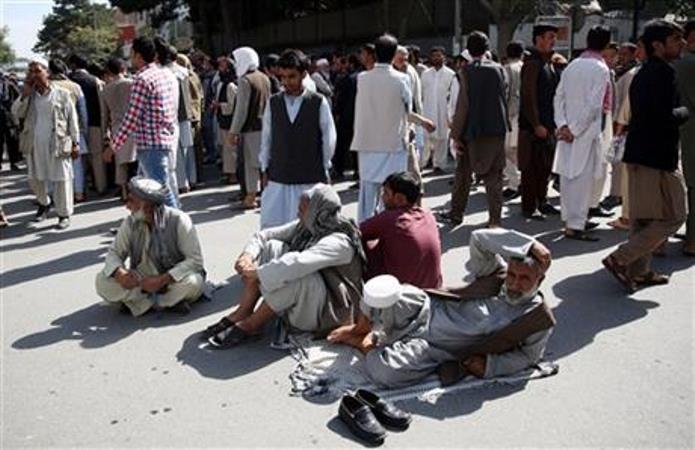
Investigators of the deadly U.S. air attack on a hospital in Afghanistan are focusing not only on how it unfolded but also on whether the decision to open fire broke the military's own rules for when to use force, officials say.
Multiple U.S. breakdowns may have led to the aerial pummeling.
At least three official investigations are underway, including a short-term NATO assessment that could open an early window into what went wrong. But on Wednesday, Doctors Without Borders, the international charity whose medical clinic was hit Saturday, called for an independent investigation, saying the attack was possibly a war crime and that U.S. and Afghan investigators cannot be relied upon to be impartial.
President Barack Obama called Joanne Liu, the group's international president to apologize and to promise a thorough and objective investigation.
In a separate call to Afghan President Ashraf Ghani, Obama offered condolences for the Afghan civilians killed and injured in the attack.
WHAT HAPPENED
Some facts are already clear, starting with the attack's tragic toll: At least 22 people were killed, including 10 patients. Doctors Without Borders has said 37 people were injured, including 19 staff members. The clinic is located in Kunduz, the northern city that Taliban fighters captured last week and held for three days before Afghan forces, supported by the U.S., launched a counteroffensive and reclaimed control of the city.
Gen. John F. Campbell, the top U.S. commander in Afghanistan, told a congressional panel on Tuesday that Afghan forces requested U.S. air power during fighting near the medical clinic. He did not reveal the full sequence of events, but he said a U.S. special operations unit that was in the "close vicinity" of the clinic spoke to the crew aboard an AC-130 gunship.
Campbell is likely to be asked for further details when he testifies before the House Armed Services Committee on Thursday.
Jason Cone, the U.S. executive director of Doctors Without Borders, told a New York news conference Wednesday the hospital staff received no warning that it would be attacked. He said there was no fighting going on in the immediate vicinity at the time, and that while wounded Taliban fighters may have been patients, the laws of war make clear that hospitals in conflict zones are to be off limits to attack. In his testimony, Campbell did not dispute this, saying the hospital was "mistakenly struck" and asserting: "We would never intentionally target a protected medical facility."
THE ATTACKERS
This was no routine air attack. Americans have become used to hearing of U.S. "airstrikes" in which a fighter, bomber or drone aircraft drops a precision-guided bomb or missile. That was not what happened in this case. It was an attack by one of the U.S. military's most fearsome weapons, the AC-130. Flying night or day, loitering at low altitude, it fires shells the likes of which would be expected to be found on a tank or a battleship.
It is known as a "gunship" because it is equipped with a 105mm howitzer, other cannons and a 25mm Gatling gun. It dates to the Vietnam War.
In the Kunduz case, the AC-130 was operating as part of a special operations task force that had gone to Kunduz after the city fell to the Taliban. Although it was flying at night, the plane's crew could identify ground targets through on-board video screens. Staff of Doctors Without Borders said the firing lasted for nearly an hour.
Cone said that as the attack was under way, the clinic's staff in Afghanistan was able to contact staff in New York, who in turn reached someone in the Pentagon to inform them that a Doctors Without Borders hospital was being assaulted. Cone said he believed that this conversation took place before the attack had ended. He also said that the medical group's staff had "reached out to both U.S. and Afghan forces" during the attack to get it halted.
WHOSE ERROR?
Campbell said Afghan troops had requested the U.S. attack, but he also made clear that the final responsibility lay with the U.S.
The U.S. military often touts the rigor of its procedures for ensuring that air power is used prudently, proportionally and with minimal risk of civilian casualties. But in this case those procedures failed. The main U.S. investigation is expected to explain why they failed and who was at fault.
Among the unanswered questions: Did the crew of the attacking aircraft know their target was a hospital? If they did, why did they open fire, and if not, why not? Cone said staff of Doctors Without Borders had provided the clinic's coordinates to the U.S. military as recently as late September. He said the clinic's location had not changed for at least four years. The U.S. military normally keeps such information up to date to avoid such mistakes.
Also unclear: Were Taliban fighters firing from inside or around the clinic?
Even the decision to answer the Afghans' call for support, regardless of the nature of the targeted building and the presence of civilians, may have been mistaken. When the U.S. combat mission in Afghanistan ended nearly a year ago, the authority to use U.S. force was narrowed. In general, force is allowed in just three circumstances: "force protection," or the defense of U.S. troops; targeting remnants of al-Qaida, and assisting Afghan forces in extreme situations where they face mass casualties. It's not clear that any of those three applied in Kunduz hospital case.
